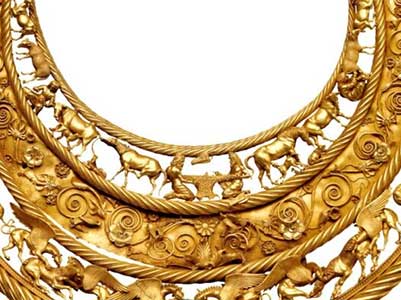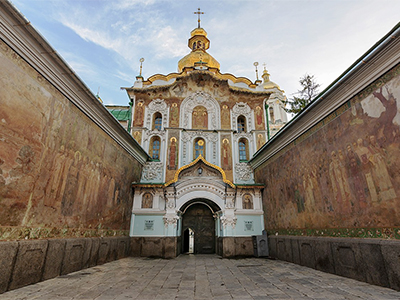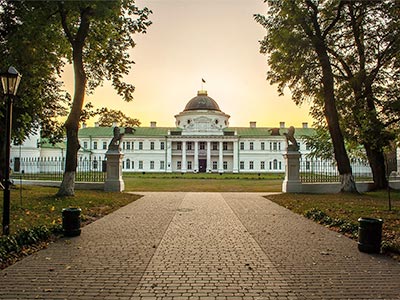 26.12.2023
The Treasure-House of Ukraine
26.12.2023
The Treasure-House of UkraineMuseum Origins and Relocation: Unveiling the Past at Kyiv-Pechersk Lavra
The Museum of Historic Jewellery of Ukraine, a branch of the National History Museum, is housed in a building that dates from the 17th-18th centuries and is situated within the walls of the sprawling Kyiv-Pechersk Lavra Monastery. This museum is not the only one on the territory of the Lavra. The museum was moved to the building it now occupies, next door to the ruins of the Cathedral of Assumption, in 1969 (the Cathedral was ruined in the Second World War).
The Museum of Historic Jewellery of Ukraine traces Ukrainian history in gold and silver; some of the artefacts date back to the Bronze Age.
The Museum houses a collection of over 55 thousand exhibits which include costume adornments and decorative accessories for weapons, riding tackle, ritual objects and everyday tableware.
It is no exaggeration to say that the Museum of Historic Jewellery of Ukraine is a treasure-house with world acclaim. Many foreign guests visit the museum every year. Many more visited its numerous exhibitions, which were organized abroad in Poland, Hungary, the USA, France, Italy and Germany.
Precious ancient objects which once formed the core of the present collection, come from the collection of Bohdan Khanenko, one of Kyiv’s patrons of the arts, well-known in his time. M. Bilyashivsky, an archeologist and the first curator of the museum, worked hard to preserve and enlarge the museum collection. D. Scherbakivsky, V. Khvolko, and many other enthusiasts of Ukrainian culture went out of their way in search of valuable ancient artefacts. Whatever they could find and purchase they gave to the museum. Unfortunately, a lot of precious ancient objects had been damaged beyond repair or simply melted down and then shaped into gold and silver bars.
Treasures Beyond Measure: A Glimpse into Ukraine’s Golden Legacy
When an object of art becomes an exhibit at a museum, it acquires a spiritual value in addition to its actual value which cannot be translated into its price in dollars, francs or any other currency.
The collection of the Scythian art objects is given a prominent place in the museum. The Scythians were nomads but in the 7th-6th centuries B.C. they seem to have settled down and formed a loosely bound state on the territory of Ukraine. Excellent pieces of antique jewellery have survived from the Scythian times; among them The Gold Pectoral from the Tovsta Mohila Burial, The Silver Cup from the Haymanov Burial and The Gold Helmet like object from the Peredriy Burial.
When we look at the tiny statuettes that decorate the three tiers of the pectoral — a fine, ritual adornment of the Scythian King — we can imagine the lyrical world of the Scythian mythology. The scenes depicted by the master of the 4th century B.C. tell us about the vernal equinox holiday and ritual murder of a sacrificial horse that personified the King. The eternal fight of Good against Evil is reflected in the scenes of fighting animals, which are characteristic of the Scythian art. The effect produced is one of uneasy admiration. Two confident, well-dressed Scythians, depicted on The Silver Cup from the Haymanov Burial, make a different Impression. Their features underline the individuality of each character. Maybe the master wanted to portray prominent Scythian personalities in a realistic fashion. Unfortunately, we can learn something about the Scythian mythology only by examining the surviving Scythian artefacts and from the books of the ancient Greek historian Herodotus. Here is one of Herodotus’ stories about the Scythians. Herodotus says that the Scythian men went away to conquer lands in Asia and after 28 years of wandering they came back to their country; upon arrival they found that the Scythian women had lured the slaves into their beds and a new generation of Scythian warriors had just arisen. This new generation, having ascertained their origin, rose in arms against those who had returned from the battles with the Medeans, and many battles were fought between the sons of slaves and the old generation of Scythian warriors.
Global Acclaim: The International Reach of Ukraine’s Jeweled Heritage
It is possible that one of such battles between the old and young Scythians is depicted on the gold object from the Perederiy Burial. The Sarmatians were the people that came to inhabit the steppes north of the Black Sea In the 4th century B. C. Their language and the way of life were close to those of the Scythians.
The burial place of a woman from the Nogaychynsky barrow in the Crimea dates from the 1st century B.C. It Is clear that this woman belonged to the Sarmatian nobility. The barrow was examined by A.O. Schepinsky in 1971. Two golden bracelets decorated with pearls and precious stones attract special attention. Their ends bear the representation of a couple in love. A bright yellow, precious stone was used to decorate the fastenings.
The museum displays decorations made from precious metals and stones that have come down to us from the Avars, Pechenegs, Polovtsys, Mongols, Huns, that is, from all those nomadic invaders whose hordes had once passed through Ukraine.
The jewellery of the Eastern Slavs and people of Kyiv Rus’ comes out to the fore in the enamel objects. The influence of the Byzantine culture, the most advanced in Europe at that time, is felt here. But when in the 11-12th centuries this technique declined in Byzantine, the Kyiv jewellers adopted it, simplified it and produced many beautiful adornments. Diadems and barmies for royal attire were made, and they were made to order. Probably, the word barmy comes from the Swedish word «barm» which means «chest». This term may have come into the language of Rus’ in the 11th century, when the noble Vikings were invited to stay at the courts of Kyiv Princes. Prince Yaroslav’s wife was Ingigerd, the Swedish King’s daughter. Harold the Severe, who was in love with Yaroslav’s daughter Elizabeth, wrote poems in which he praised himself but finished every stanza with the following words: «Only the maiden with a golden grivna (necklace) oh her neck ignores me.»
Guardians of the Collection: Preserving Ukraine’s Cultural Heritage
The barmies from the Museum of Historic Jewellery of Ukraine were found in 1900, near the village of Sakhnivka among the treasures of a prince, which included ornaments and a gold diadem. Depicted on them are Christ, the Virgin and the Saints. They are framed II by pearls and multicoloured precious stones, which were meant to harmonize with the bright golden cloth of the prince’s regalia.
The cross that comes from B.l. Kha-nenko’s collection is a very interesting object. In the middle of it there is a golden plate with the image of Mariya Oranta in the enamel technique of the Byzantine masters of the 11th century. But the cross itself is a wonderful Byzantine stylization, though it is decorated with real diamonds, rubies, emeraids and sapphires. The frame that looks like a cross was made at the end of the 19th century, maybe by Y. Marshak’s jewellers.
The Ukrainian jewellers inherited the skills of Kyiv Rus’ jewellers, The works of Ukrainian goldsmiths of the 17-18th centuries are characterized by refined taste, perfect forms and excellent technique. The fine mitre of Kyiv and Galitsiya Metropolitans, who in accordance with the tradition were at the same time abbots of Kyiv-Pechersk Lavra, was made in the first half of the 18th century. Enamel medallions, framed by pearls offer examples of a pictorial enamel art. Antony and Theodosius, the founders of Kyiv-Pechersk Monastery, are depicted on one of them. The precious stones to decorate the me* dallions were chosen with great care.
The mitre is decorated with 539 diamonds, 167 rubies, 54 emeralds, 13 sapphires.
-
 27.02.2024
World of pysanka
Embark on a journey into the captivating world of Pysanka, the Ukrainian...
27.02.2024
World of pysanka
Embark on a journey into the captivating world of Pysanka, the Ukrainian...
-
 29.01.2024
Exploring the Treasures of Kyiv’s Lavra Monastery
In the heart of Kyiv lies the venerable Lavra Monastery, a testament...
29.01.2024
Exploring the Treasures of Kyiv’s Lavra Monastery
In the heart of Kyiv lies the venerable Lavra Monastery, a testament...
-
 13.01.2024
Kachanivka, Eden on Earth
Rich in history, it hosted renowned artists, notably poet Taras Shevchenko.
13.01.2024
Kachanivka, Eden on Earth
Rich in history, it hosted renowned artists, notably poet Taras Shevchenko.

